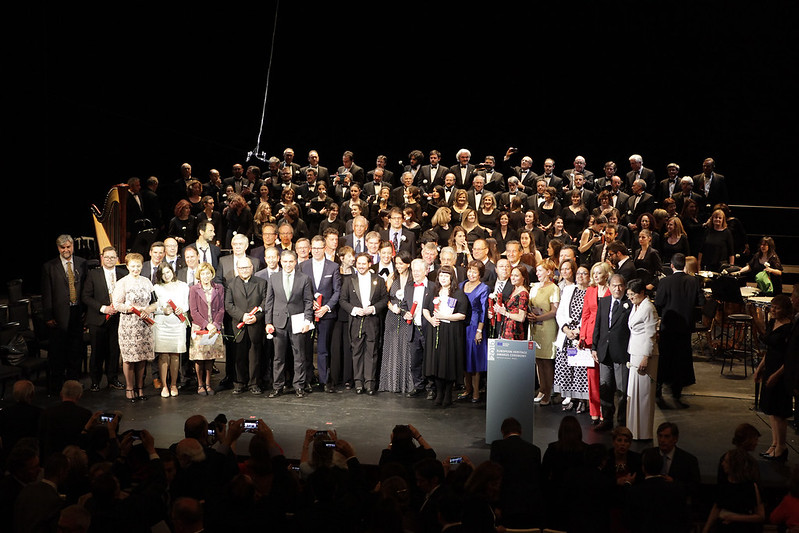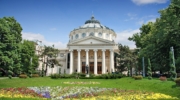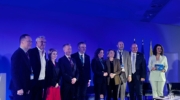Plácido Domingo and EU Commissioner Navracsics Announce Grand Prix Winners of the European Heritage Awards 2016 in Madrid
The winners of the 2016 EU Prize for Cultural Heritage / Europa Nostra Awards, Europe’s top honour in the field, were celebrated this evening during a high-profile event at the Zarzuela Theatre in Madrid. Maestro Plácido Domingo, President of Europa Nostra, the leading heritage organisation in Europe, and Tibor Navracsics, European Commissioner for Education, Culture, Youth and Sport, co-hosted the European Heritage Awards Ceremony and presented the 7 Grand Prix and the Public Choice Award, chosen from among the 28 winning projects of this year.

The 7 Grand Prix laureates, selected by independent expert juries and entitled to receive €10,000 each, are:
Category Conservation
▪ Traditional Watermill in Agios Germanos, Prespes, Greece
▪ The King’s Little Pathway in El Chorro gorge, Malaga, Spain
▪ Wimpole Hall’s Gothic Tower in Wimpole, Cambridgeshire, United Kingdom
Category Research
▪ Conservation study of the village Gostuša in Pirot district, Serbia
Category Dedicated Service
▪ Employees and Activists of the National Museum of Bosnia and Herzegovina in Sarajevo, BiH
▪ Mrs. Giulia Maria Crespi, Milan, Italy
Category Education, Training and Awareness-Raising
▪ ‘Adopt a Monument’, Tampere, Finland
The rehabilitation of The King’s Little Pathway is the big winner of this year: the expert jury granted it a Grand Prix while the general public selected it as their favourite heritage project in Europe. Some 8,000 people voted for the Public Choice Award. The online vote, which is in its fifth edition, was conducted via the Europa Nostra website.
During the ceremony, the EU Prize for Cultural Heritage / Europa Nostra Awards were presented to 28 winners from 16 countries taking part in the EU’s Creative Europe programme. A Europa Nostra Award was also given to an achievement from Belarus, a European country not taking part in the programme.
“For 14 years now, with the EU Prize for Cultural Heritage / Europa Nostra Awards, we have been celebrating remarkable achievements in our unique tangible and intangible cultural heritage. The quality and diversity of this year’s projects highlight the dedication and the excellent skills of the winners and their teams. Once again the winning projects reveal the positive impact that the heritage sector has on enhancing civic responsibility, social cohesion, sustainable economic growth, regional and local development and also in inspiring creativity and innovation. I am happy to propose to make 2018 the European Year of Cultural Heritage, which indicates the importance of heritage and provides an excellent opportunity to enhance awareness of our cultural heritage and its educational potential. I warmly congratulate all the winners, and especially the Grand Prix laureates and the Public Choice Award winner,” stated Tibor Navracsics, European Commissioner for Education, Culture, Youth and Sport.
“It has been an immense pleasure to meet and pay tribute to all Award winners and to celebrate the best of our shared heritage, together with hundreds of professionals, volunteers and supporters from all over Europe. During this memorable event, we have also welcomed the Commission’s intention to hold the European Year of Cultural Heritage in 2018. At a time when the European Union is confronted with many political, economic and social challenges, this initiative has a very special meaning. Cultural heritage, indeed, connects people across generations and across borders, generates economic growth and fosters social inclusion. This would be an unprecedented opportunity for the EU Institutions, the Member States and Europe’s civil society to join forces to ensure that cultural heritage takes its rightful place in all relevant EU policies and actions. Europa Nostra is fully committed to contributing to the implementation of this momentous Year with expertise and creativity,” affirmed Plácido Domingo, the renowned opera singer and President of Europa Nostra.
The event was attended by 1.000 people, including heritage professionals, volunteers and supporters from all over Europe as well as top-level representatives from EU institutions, Member States and the host country.
Íñigo Méndez de Vigo, Acting Minister for Education, Culture and Sport, addressed the audience.
The Awards Ceremony is the main highlight of the European Heritage Congress, organised by Europa Nostra in cooperation with its country representation Hispania Nostra, which has brought hundreds of heritage players from all over Europe to Madrid on 22-27 May.
The Call for Entries for the Awards 2017 is posted online. The deadline for applications is 1 October 2016.
7 Grand Prix laureates
Category Conservation
Traditional Watermill in Agios Germanos, Prespes, GREECE
This traditional watermill, located in the mountainous region of the National Park of Prespa, was built in 1930. The restoration involved repairing the derelict building, reconstructing the destroyed mechanical systems (one which grinds flour, another for cleaning fabrics and the third for textile finishing), rebuilding the water supply system and installing new constructions in the surrounding area so that the mill is easily accessible to visitors. The project was ambitious with the goal being to create a “living monument” of the region’s industrial heritage as well as reinstating the production of edible flour, which would in turn enhance and support traditional occupations in the village and the cultivation of organic cereals in the surrounding area. “With this Grand Prix, we commend the recovery of this early industrial mill which is highly characteristic of industrialisation in Europe,” stated the jury, who also noted “the high educational and social engagement which contributed to the sustainable economic and environmental development in the village and in the region on a wider scale”.
The King’s Little Pathway in El Chorro gorge, Malaga, SPAIN (also Public Choice Award)
This suspended walkway brings visitors high up through the Gaitanejo and los Gaitanes gorge in the province of Malaga, an area of phenomenal natural beauty. The path was constructed in the early 20th century to enable the population of El Chorro village to access the hydroelectric plant where most of the inhabitants worked. With the walkway in place, the villagers could avoid travelling the long way around the mountain. Children also used the route to walk to the nearby school. In recent times, the King’s Little Pathway had become a popular hiking destination. However the crumbling nature of the aged structure resulted in it being dubbed “one of the world’s scariest hikes”. “The renovation of the King’s Little Pathway has opened up this unique example of natural and industrial heritage to all visitors and this Grand Prix is in recognition of this achievement. Its improvement has been successful in attracting a new wave of tourism to the area”, affirmed the jury, who also praised the conservation team for building a path which incorporated or was just above the original walkway.
Wimpole Hall’s Gothic Tower in Wimpole, Cambridgeshire, UNITED KINGDOM
The Gothic Tower in the park of Wimpole Hall is a superb pseudo-medieval ruin of a castle, based on a sketch by the architect Sanderson Miller in 1749. This iconic ruin has served as an example for the construction of similar structures in Europe. Over the centuries, the Tower suffered extensive damage due to the vulnerability of its carefully-designed broken edges, blank windows, missing battlements and lack of a roof. Its crenellation – the pattern of stonework found along the top of the walls – which was such an important characteristic of the Gothic Tower was almost completely missing. “Intellectually, this project raises interesting questions about the preservation of a designed ruin and inspires thought about the nature of conservation. It is informed by detailed research and archaeological recordings and is a model of cooperative endeavour. Its clever restoration has returned this beautiful landmark to the public and has enriched our knowledge of the social and cultural history of the estate. This Grand Prix is awarded in recognition of this diligent work”, highlighted the jury.
Category Research
Conservation study of the village Gostuša in Pirot district, SERBIA
The researchers carried out an architectural survey on each building of the Gostuša village, located in the Pirot district, and produced detailed and comprehensive documentation regarding the architecture and construction techniques used in each individual structure. The study had a compelling educational element with a strong engagement from students in the relevant fields. While the protection of the vernacular architecture is apparent, the study went beyond these material factors in boosting the cultural identity of the area and providing new potential for social and economic growth in this region. “The conservation study of endangered vernacular architecture in this small but unique mountain village is a testament to the accomplished work and high standard of conservation which can be achieved with firm commitment in spite of a limited budget. The research for the conservation work was remarkably thorough and was conducted with vision and a clear action plan. This Grand Prix is awarded in recognition of the far reaching successes of this research”, stressed the jury.
Category Dedicated Service
Employees and Activists of the National Museum of Bosnia and Herzegovina in Sarajevo, BiH
The National Museum of Bosnia and Herzegovina in Sarajevo is home to over 4 million artefacts making it one of the most important museum collections in South East Europe. Deprived of public funding and support, the Museum shut its doors in 2012. However, despite the closure, the employees continued to come to work every day over the following three years without pay. They guarded the Museum night and day in poor conditions and cared for the artefacts as best they could. “Their commitment to their vocations, which was publicly articulated through the large-scale civic campaign conducted by the independent cultural NGO AKCIJA, mobilised massive support from the public and the media in Bosnia and Herzegovina and beyond. Finally, it influenced policy at a state level,” stated the jury. The Museum reopened in September 2015 with a guarantee of public funding until 2018. “This victory for civil engagement in cultural heritage is truly impressive and we celebrate their achievement with this Grand Prix”, emphasized the jury.
Mrs. Giulia Maria Crespi, Milan, ITALY
From a young age, Mrs. Giulia Maria Crespi has had an active role in charitable activities and has devoted her life to the vigorous defence of Italy’s cultural heritage. In 1975, Mrs. Crespi co-founded FAI – Fondo Ambiente Italiano, a non-profit organisation modelled on the National Trust of England, Wales and Northern Ireland. Until 2010 she served as a tireless and generous leader of the organisation. FAI has been responsible for an extensive number of high-quality conservation, educational and awareness-raising projects. The jury noted that “with her strong personality and leadership, Mrs. Crespi has had a direct influence on policy and decision-making with regard to cultural heritage in Italy. She has challenged the authorities time and again and mobilised private and public support to protect Italy’s landscape and heritage. Her many achievements serve as a legacy for present and future generations. With this Grand Prix, we pay tribute to an outstanding individual for her voluntary dedication to saving cultural heritage”.
Category Education, Training and Awareness-Raising
‘Adopt a Monument’, Tampere, FINLAND
This grassroots project, facilitated by the Pirkanmaa Provincial Museum, encourages citizens to ‘adopt’ monuments of cultural and historical significance in their environment and return them to use. As caretakers of the monuments, they also contribute to raising awareness in the local communities about their heritage. ‘Adopt a Monument’ has enjoyed tremendous popularity in the Pirkanmaa region and has started to gradually spread throughout the rest of the country. “The volunteers who arrange the ‘adoptions’ are supported by professionals in museums and the projects for the restoration of the buildings are aided by conservation professionals. The enthusiasm from the volunteers coupled with the expertise of the professionals has resulted in a credible and highly efficient project which has had a great impact despite its modest budget. The project’s potential to be applied across Europe is evident”, affirmed the jury. “This Grand Prix is in commendation of the work of those involved with this project and the tremendous effort that they have put into promoting good, active citizenship and encouraging the commitment of the local communities to their local heritage,” highlighted the jury.
Watch videos
Ceremony Trailer
Ceremony full version
Press releases
Bosnian
French
English
Finnish
Greek
Italian
Serbian
Spanish
Joana Pinheiro
Europa Nostra Communications Officer
jp@europanostra.org
+31 70 302 40 55
Nathalie Vandystadt
Europe Creative Communications Officer
nathalie.vandystadt@ec.europa.eu
+32 2 2967083







